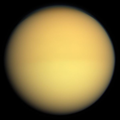| ¡Vikidia te necesita! Actualmente tenemos 6602 artículos. ¡Anímate! |
Archivo:Two Halves of Titan.png
Two_Halves_of_Titan.png (600 × 600 píxeles; tamaño de archivo: 108 kB; tipo MIME: image/png)
Resumen
| DescripciónTwo Halves of Titan.png |
English: Seasonal changes in the atmosphere of Saturn's largest moon are captured in this natural-colour image which shows Titan with a slightly darker top half and a slightly lighter bottom half. Titan's atmosphere has a seasonal hemispheric dichotomy, and this image was taken shortly after Saturn's August 2009 equinox. Images taken using red, green and blue spectral filters were combined to create this natural-colour view. Scientists have found that the winter hemisphere typically appears to have more high-altitude haze, making it darker at shorter wavelengths (ultraviolet through blue) and brighter at infra-red wavelengths. The switch between dark and bright occurred over the course of a year or two around the last equinox. Scientists are studying the mechanism responsible for this change, and will monitor the dark-light difference as it flip-flops now that the 2009 equinox has signalled the coming of spring and then summer in the northern hemisphere. Although this hemispheric boundary appears to run directly east-west near the equator, its position is not level with latitude and is actually offset from the equator by about 10 degrees of latitude.
This view looks toward the Saturn-facing side of Titan (5150 kilometres across). North on Titan is up. The images were obtained with the Cassini spacecraft wide-angle camera at a distance of approximately 174,000 kilometres from Titan. Image scale is 10 kilometres per pixel.
Deutsch: Dieses Bild zeigt jahreszeitliche Unterschiede in der Farbe der Atmosphäre von Saturns größtem Mond Titan mit etwas dunklerer nördlicher Hälfte und etwas hellerer südlicher Hälfte. Dieses Bild wurde im August 2009 von der NASA Sonde Cassini aufgenommen und gibt die Echtfarben wieder, entstanden aus der Kombination von Bildern mit Rot-, Grün- und Blaufiltern. Forscher haben herausgefunden dass die Winter-Hemisphäre in der Regel einen stärkeren Dunstschleier in den oberen Teilen der Atmosphäre zeigt und daher dunkler in kürzeren Wellenlängen des Lichtes (Ultraviolet bis Blau) wirkt und heller im infraroten Bereich.
Der Wechsel zwischen dunkleren und helleren Hemisphären fand über einen Zeitraum von ein bis zwei Jahren statt und hängt mit der Tag-und-Nacht-Gleiche Saturns zusammen, findet also zweimal je Saturnjahr statt. Die Grenze zwischen hellerer und dunklerer Hälfte verläuft nicht direkt am Äquator, sondern ist etwa 10 Breitengrade versetzt. Das Bild zeigt die Seite Titans, die dem Saturn zugewandt ist. Norden ist oben, aufgenommen aus einer Entfernung von 174.000 Kilometern. Maßstab des Bildes ist etwa 10 Kilometer pro Pixel. |
||
| Fecha | |||
| Fuente |
[http://ciclops.org/view/5810/Two_Halves_of_Titan or http://photojournal.jpl.nasa.gov/catalog/PIA11603
|
||
| Autor | NASA/JPL/Space Science Institute |
Licencia
| Public domainPublic domainfalsefalse |
| Este archivo es de dominio público porque fue creado por la NASA. Las políticas sobre copyright de la NASA estipulan que «el material de la NASA no está protegido con copyright a menos que se indique lo contrario». (Políticas sobre copyright de la NASA o Políticas sobre la utilización de imágenes del Jet Propulsion Laboratory). |  | |
 |
Advertencias:
|
Leyendas
Elementos representados en este archivo
representa a
25 ago 2009
Historial del archivo
Pulsa sobre una fecha/hora para ver el archivo en ese momento.
| Fecha y hora | Miniatura | Dimensiones | Usuario | Comentario | |
|---|---|---|---|---|---|
| actual | 12:34 14 jul 2015 |  | 600 × 600 (108 kB) | wikimediacommons>JorisvS | rv: only black is cropped away |
Usos del archivo
La siguiente página usa este archivo:


